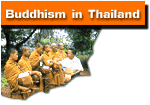 Sukhothai Period Sukhothai Period |
 Although animistic beliefs
remained potent in Sukhothai, King Ramkhamhaeng and his
successors were all devout Buddhist rulers who made merit
on a large scale. The major cities of the Sukhothai kingdom
were, therefore, full of monasteries, many of which were
splendid examples of Thai Buddhist architecture. Sukhothai
adopted the Ceylonese school of Theravada Buddhism, beginning
with King Ramkhamhaeng's invitation to Ceylonese monks
to come over and purify Buddhism in his kingdom. This
Ceylonese influence manifested itself not only in matters
of doctrine but also in religious architecture. The bell-shaped
stupa, so familiar in Thai religious architecture, was
derived from Ceylonese models. Sukhothai style Buddha
images are distinctive for their elegance and stylized
beauty, and Sukhothai's artists introduced the graceful
form of the "walking Buddha" into Buddhist sculpture. Although animistic beliefs
remained potent in Sukhothai, King Ramkhamhaeng and his
successors were all devout Buddhist rulers who made merit
on a large scale. The major cities of the Sukhothai kingdom
were, therefore, full of monasteries, many of which were
splendid examples of Thai Buddhist architecture. Sukhothai
adopted the Ceylonese school of Theravada Buddhism, beginning
with King Ramkhamhaeng's invitation to Ceylonese monks
to come over and purify Buddhism in his kingdom. This
Ceylonese influence manifested itself not only in matters
of doctrine but also in religious architecture. The bell-shaped
stupa, so familiar in Thai religious architecture, was
derived from Ceylonese models. Sukhothai style Buddha
images are distinctive for their elegance and stylized
beauty, and Sukhothai's artists introduced the graceful
form of the "walking Buddha" into Buddhist sculpture.
Sukhothai's cultural importance
in Thai history also derives from the fact that the
Thai script evolved into a definite form during King
Ramkhamhaeng's time, taking as its models the ancient
Mon and Khmer scripts. Indeed, this remarkable king
is credited with having invented the Thai script.
King Si Inthrathit and
King Ramkhamhaeng were both warrior kings and extended
their territories far and wide. Their successors, however,
could not maintain such a far-flung empire. Some of
these later kings were more remarkable for their religious
piety and extensive building activities than for their
warlike exploits. An example of this type of Buddhist
ruler was King Mahathammaracha Lithai, believed to have
been the compiler of the Tribhumikatha, an early Thai
book on the Buddhist universe or cosmos. The political
decline of Sukhothai was, however, not wholly owing
to deficiencies in leadership. Rather it resulted from
the emergence of strong Thai states further south, whose
political and economic power began to challenge Sukhothai
during the latter half of the 14th century. These southern
states, especially Ayutthaya, were able to deny Sukhothai
access to the area.
The Sukhothai kingdom
did not die a quick death. Its decline lasted from the
mid-14th until the 15th century. In 1378, the Ayutthaya
King Borommaracha I subdued Sukhothai's frontier city
of Chakangrao [Kamphaengphet], and henceforth Sukhothai
became a tributary state of Ayutthaya. Sukhothai later
attempted to break loose from Ayutthaya but with no
real success, until in the 15th century it was incorporated
into the Ayutthaya kingdom as a province. The focus
of Thai history and politics now moved to the central
plains of present-day Thailand, where Ayutthaya was
establishing itself as a centralized state, its power
outstripping not only Sukhothai but also other neighbouring
states such as Suphannaphum and Lawo [Lopburi]
|



 Although animistic beliefs
remained potent in Sukhothai, King Ramkhamhaeng and his
successors were all devout Buddhist rulers who made merit
on a large scale. The major cities of the Sukhothai kingdom
were, therefore, full of monasteries, many of which were
splendid examples of Thai Buddhist architecture. Sukhothai
adopted the Ceylonese school of Theravada Buddhism, beginning
with King Ramkhamhaeng's invitation to Ceylonese monks
to come over and purify Buddhism in his kingdom. This
Ceylonese influence manifested itself not only in matters
of doctrine but also in religious architecture. The bell-shaped
stupa, so familiar in Thai religious architecture, was
derived from Ceylonese models. Sukhothai style Buddha
images are distinctive for their elegance and stylized
beauty, and Sukhothai's artists introduced the graceful
form of the "walking Buddha" into Buddhist sculpture.
Although animistic beliefs
remained potent in Sukhothai, King Ramkhamhaeng and his
successors were all devout Buddhist rulers who made merit
on a large scale. The major cities of the Sukhothai kingdom
were, therefore, full of monasteries, many of which were
splendid examples of Thai Buddhist architecture. Sukhothai
adopted the Ceylonese school of Theravada Buddhism, beginning
with King Ramkhamhaeng's invitation to Ceylonese monks
to come over and purify Buddhism in his kingdom. This
Ceylonese influence manifested itself not only in matters
of doctrine but also in religious architecture. The bell-shaped
stupa, so familiar in Thai religious architecture, was
derived from Ceylonese models. Sukhothai style Buddha
images are distinctive for their elegance and stylized
beauty, and Sukhothai's artists introduced the graceful
form of the "walking Buddha" into Buddhist sculpture.